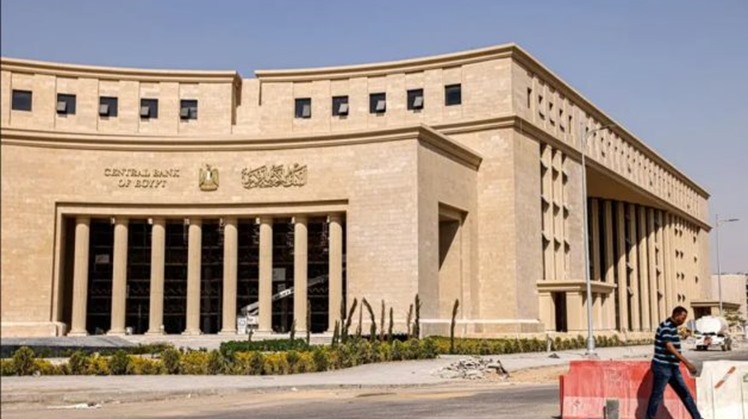CAIRO – 16 June 2025: Egypt’s banking sector experienced a notable increase in February 2025, as the combined financial standing of all banks operating within the domestic market—excluding the Central Bank of Egypt—reached LE 22.039 trillion, reflecting a monthly growth of LE 745 billion from the LE 21.294 trillion recorded in January.
On the asset side, banks reported LE 183.588 billion in cash holdings, LE 3.640 trillion in interbank balances within Egypt, and LE 1.117 trillion in balances with foreign banks.
Customer loans and discounts climbed to LE 8.848 trillion, while investments in securities and treasury bills reached LE 6.837 trillion. Other assets were recorded at LE 1.411 trillion.
Bank capital stood at LE 579.378 billion as of February, with reserves amounting to LE 836.769 billion and provisions at LE 598.426 billion.
Interbank liabilities domestically totaled LE 1.849 trillion, while liabilities to foreign banks reached LE 605.554 billion. Long-term loans and bonds amounted to LE 918.556 billion, and other liabilities were recorded at LE 2.618 trillion.
Customer deposits continued to rise sharply, growing by LE 330 billion in just one month to reach LE 14.151 trillion in February, up from LE 13.821 trillion in January.
Of this total, government deposits amounted to LE 2.977 trillion—comprising LE 2.486 trillion in local currency and the equivalent of LE 490.571 billion in foreign currencies.
Non-government deposits were valued at LE 11.174 trillion, split between LE 8.019 trillion in local currency and LE 3.154 trillion equivalent in foreign currencies.
Among local currency deposits, the household sector held LE 6.439 trillion, followed by the private business sector at LE 1.354 trillion, the public business sector at LE 190.125 billion, and non-residents at LE 36.513 billion.
For non-government foreign currency deposits, households accounted for LE 1.816 trillion, private businesses held LE 1.037 trillion, public businesses held LE 184.228 billion, and non-residents LE 116.873 billion.
Credit facilities provided by banks surged to LE 8.848 trillion in February 2025, up significantly from LE 7.209 trillion in June 2024—a rise of approximately LE 1.639 trillion. These facilities encompass loans, letters of credit, and guarantees issued primarily to facilitate imports.
The increase was driven largely by a jump in credit to the government sector, which rose by LE 1.077 trillion (30.1 percent). Credit to non-government entities also expanded, increasing by LE 561.5 billion (15.5 percent). Of the government-related credit growth, LE 566.9 billion was in local currency and LE 510.8 billion in foreign currency equivalents.
As of February, 60.1% of credit facilities extended to the non-government sector were directed toward private businesses. Sector-wise, industry received 33.1%, services 27.6%, trade 8.5%, and agriculture 1.7%. Unclassified sectors, mostly households, made up 29.1%.
Between July 2024 and February 2025, domestic liquidity in the banking system rose by LE 1.6 trillion, reaching LE 12.218 trillion—a growth rate of 15.1%.
This growth was supported by an increase in quasi-money of LE 1.247 trillion (15.8%) and a rise in the money supply of LE 352.8 billion (13.1%). The quasi-money increase was fueled by a LE 736.7 billion rise in non-current local currency deposits and LE 510.3 billion equivalent in foreign currency deposits. Meanwhile, the money supply saw an increase in current local currency deposits of LE 382.2 billion, slightly offset by a LE 29.4 billion decline in currency circulating outside the banking system.
Net domestic assets rose by LE 1.710 trillion (17.1%) during the July–February period. This was driven by a substantial LE 3.176 trillion increase in domestic credit, which included LE 2.601 trillion in net claims on the government, LE 312.1 billion on private businesses, LE 83 billion on public businesses, and LE 180 billion on households.
On the other hand, net foreign assets in the banking system declined by LE 110.8 billion (17.7%). The drop was attributed to a LE 229.3 billion reduction in foreign assets at commercial banks, partially offset by an LE 118.5 billion rise in the Central Bank’s foreign assets.
Reserve money in the economy climbed by LE 387.6 billion (19.7%) during the same period, reaching LE 2.352 trillion. This was mainly due to a LE 419 billion increase in local currency deposits held by banks at the Central Bank. Meanwhile, cash outside the CBE's vaults declined by LE 31.4 billion.
The rise in reserve money was attributed to several factors, including LE 295.8 billion in increased net claims on the government, a LE 118.5 billion increase in net foreign assets, and LE 87.5 billion in net budget items—offset slightly by a LE 114.2 billion drop in net claims on banks.
 Mon, Jun. 16, 2025
Mon, Jun. 16, 2025